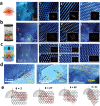2+δ-Dimensional Materials via Atomistic Z-Welding
- PMID: 36089664
- PMCID: PMC9661819
- DOI: 10.1002/advs.202202695
2+δ-Dimensional Materials via Atomistic Z-Welding
Abstract
Pivotal to functional van der Waals stacked flexible electronic/excitonic/spintronic/thermoelectric chips is the synergy amongst constituent layers. However; the current techniques viz. sequential chemical vapor deposition, micromechanical/wet-chemical transfer are mostly limited due to diffused interfaces, and metallic remnants/bubbles at the interface. Inter-layer-coupled 2+δ-dimensional materials, as a new class of materials can be significantly suitable for out-of-plane carrier transport and hence prompt response in prospective devices. Here, the discovery of the use of exotic electric field ≈106 V cm- 1 (at microwave hot-spot) and 2 thermomechanical conditions i.e. pressure ≈1 MPa, T ≈ 200 °C (during solvothermal reaction) to realize 2+δ-dimensional materials is reported. It is found that Pz Pz chemical bonds form between the component layers, e.g., CB and CN in G-BN, MoN and MoB in MoS2 -BN hybrid systems as revealed by X-ray photoelectron spectroscopy. New vibrational peaks in Raman spectra (BC ≈1320 cm-1 for the G-BN system and MoB ≈365 cm-1 for the MoS2 -BN system) are recorded. Tunable mid-gap formation, along with diodic behavior (knee voltage ≈0.7 V, breakdown voltage ≈1.8 V) in the reduced graphene oxide-reduced BN oxide (RGO-RBNO) hybrid system is also observed. Band-gap tuning in MoS2 -BN system is observed. Simulations reveal stacking-dependent interfacial charge/potential drops, hinting at the feasibility of next-generation functional devices/sensors.
Keywords: 2+ δ dimensional; 2D materials; hybridization; hydrothermal; microwave.
© 2022 The Authors. Advanced Science published by Wiley-VCH GmbH.
Conflict of interest statement
The authors declare no conflict of interest.
Figures






References
-
- Kirill B. I., Ghahari F., Shulman M. D., Stormer H. L., Kim P., Nature 2009, 462, 196. - PubMed
-
- Bolotin K. I., Sikes K. J., Jiang Z., Klima M., Fudenberg G., Hone J., Kim P., Stormer H. L., Solid State Commun. 2008, 146, 351.
-
- Dean C. R., Young A. F., Meric I., Lee C., Wang L., Sorgenfrei S., Watanabe K., Taniguchi T., Kim P., Shepard K. L., Hone J., Nat. Nanotechnol. 2010, 5, 722. - PubMed
Grants and funding
LinkOut - more resources
Full Text Sources
Miscellaneous
